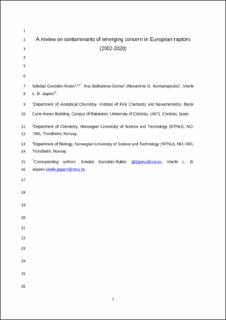| dc.contributor.author | González-Rubio, Soledad | |
| dc.contributor.author | Ballesteros-Gómez, Ana | |
| dc.contributor.author | Asimakopoulos, Alexandros | |
| dc.contributor.author | Jaspers, Veerle | |
| dc.date.accessioned | 2021-03-03T12:52:48Z | |
| dc.date.available | 2021-03-03T12:52:48Z | |
| dc.date.created | 2021-01-10T17:38:31Z | |
| dc.date.issued | 2021 | |
| dc.identifier.citation | Science of the Total Environment. 2021, (760), . | en_US |
| dc.identifier.issn | 0048-9697 | |
| dc.identifier.uri | https://hdl.handle.net/11250/2731440 | |
| dc.description.abstract | Raptors (birds of prey and owls) have been widely used as suitable bioindicators of environmental pollution. They occupy the highest trophic positions in their food chains and are documented to bioaccumulate high concentrations of persistent pollutants such as toxic metals and legacy persistent organic pollutants (POPs).Whereas raptors played a critical role in developing awareness of and policy for chemical pollution, they have thus far played a much smaller role in current research on contaminants of emerging concern (CECs). Given the critical knowledge obtained from monitoring ‘legacy contaminants’ in raptors, more information on the levels and effects of CECs on raptors is urgently needed. This study critically reviews studies on raptors from Europe reporting the occurrence of CECs with focus on the investigated species, the sampled matrices, and the bioanalytical methods applied. Based on this, we aimed to identify future needs for monitoring CECs in Europe. Perfluoroalkyl substances (PFASs), novel flame retardants (NFRs), and to a lesser extent UV-filters, neonicotinoids, chlorinated paraffins, parabens and bisphenols have been reported in European raptors. White-tailed Eagle (Haliaeetus albicilla), Peregrine falcon (Falco peregrinus) and Northern goshawk (Accipiter gentilis) were the most frequently studied raptor species. Among matrices, eggs, feathers and plasma were the most widely employed, although the potential role of the preen gland as an excretory organ for CECs has recently been proposed. This review highlights the following research priorities for pollution research on raptors in Europe: 1) studies covering all the main classes of CECs; 2) research in other European regions (mainly East Europe); 3) identification of the most suitable matrices and species for the analysis of different CECs; and 4) the application of alternative sample treatment strategies (e.g. QuEChERS or pressurized liquid extraction) is still limited and conventional solvent-extraction is the preferred choice. | en_US |
| dc.language.iso | eng | en_US |
| dc.publisher | Elsevier | en_US |
| dc.rights | Attribution-NonCommercial-NoDerivatives 4.0 Internasjonal | * |
| dc.rights.uri | http://creativecommons.org/licenses/by-nc-nd/4.0/deed.no | * |
| dc.title | A review on contaminants of emerging concern in European raptors (2002−2020) | en_US |
| dc.type | Peer reviewed | en_US |
| dc.type | Journal article | en_US |
| dc.description.version | acceptedVersion | en_US |
| dc.source.pagenumber | 20 | en_US |
| dc.source.journal | Science of the Total Environment | en_US |
| dc.source.issue | 760 | en_US |
| dc.identifier.doi | 10.1016/j.scitotenv.2020.143337 | |
| dc.identifier.cristin | 1868377 | |
| dc.description.localcode | "© 2020. This is the authors’ accepted and refereed manuscript to the article. Locked until 4.11.2022 due to copyright restrictions. This manuscript version is made available under the CC-BY-NC-ND 4.0 license http://creativecommons.org/licenses/by-nc-nd/4.0/ " | en_US |
| cristin.ispublished | true | |
| cristin.fulltext | postprint | |
| cristin.qualitycode | 2 | |

